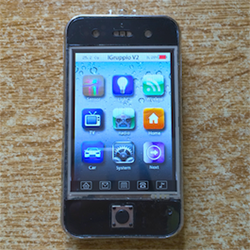 A few years ago, [Michele] built a mobile device with a touch screen, a relatively powerful processor, and a whole bunch of sensors. To be honest, the question of why he built this was never asked because it’s an impressive display of electronic design and fabrication. [Michele] calles it the iGruppio. Although it’s not a feature-packed cell phone, it’s still an impressive project that stands on its own merits.
A few years ago, [Michele] built a mobile device with a touch screen, a relatively powerful processor, and a whole bunch of sensors. To be honest, the question of why he built this was never asked because it’s an impressive display of electronic design and fabrication. [Michele] calles it the iGruppio. Although it’s not a feature-packed cell phone, it’s still an impressive project that stands on its own merits.
Inside the iGruppio is a Pic32mx microcontroller, a 240×320 TFT touchscreen, and enough sensors to implement a 10 DOF IMU. The software written for the iGruppio is heavily inspired by the iPhone and a completely homebrew project – all the software was written by [Michele] himself. While the first version of the iGruppio was a little clunky, the second revision (seen in the pic above) uses an old iPhone case to turn a bunch of boards and plugs into a surprisingly compact device.
No, there’s no cellular modem inside the latest version, but [Michele] has put all the sources up on Github, and anyone wanting to build a homebrew cell phone could do worse than to take a look at his work. Video demo below.
















He built a PDA, not a phone.
I was thinking the exact same thing.
i guess you could say he built an ipod touch clone”ish”, that would be a little more accurate
Then he jailbroke it and ended up denying support to himself.
Now he can’t even use his own app store and he’s like the ONLY guy…
Props!
http://i.imgur.com/f1kg7MH.png
Heh.
Didn’t know if anyone else saw that.
hahahahahah
Awesome work for ONE MAN. Anyone wishing to insult him, please post your greatest creation first. Mine would be a chicken coop that hasn’t fallen down. Thus, my lack of criticism.
I do not believe anyone here was insulting him, more the title and writings here that would lead some to believe this was somehow a phone
Getting all the goodness to fit just has to be the most impressive feat in all this. Whatever you want to call it, I call it compact!
Please, change the title of the article to something like “Building A Awesome Home Made iPod Touch” so people can quit complaining about the title and give [Michele] the props he totally deserves!
I like this from a ‘universal remote’ point of view. I have some aging Philips Prontos that i know will die at some point, and I really want to be able to replace them with an open source remote design complete with large colour touchscreen… has anyone built one?
Freaking awesome!
i build a homemade iPhone every time i sit on the commode
I laughed at that far more than I really should have ;^>
I wouldn’t call this an iPhone or even an iPod Touch or PDA — I’d call it a touchscreen thermostat; that’s about as powerful as it is.
Not only does this lack a cellular radio (which others have pointed out), it uses a tiny PIC32 microcontroller; not an application processor. This puts it in a completely different class of devices, and dramatically reduces the usefulness of the device — instead of running Android/Linux apps, it runs a single, monolithic software image, written in bare-metal C.
Basically, it’s an PIC32 dev kit in a fancy case. Boring.
Heh, if you toss a cell board in there, you can give the NSA fits. No direct hardcoded backdoor for them to play with. :D